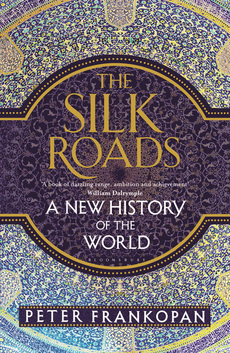 Oh dear Persia, fatherland of serendipity
Oh dear Persia, fatherland of serendipity
Living in the west of the European peninsula, we don't understand geography. Persian culture serves as a bridge linking the East and the West.
For instance, Frankopan's book -his page here
The Silk Roads were no exotic series of connections, but networks that linked continents and oceans together. They were - and still are - the world's central nervous system. This is where empires were won - and where they were lost. As a new era emerges, the patterns of exchange are mirroring those that have criss-crossed Asia for millennia.
As in his case,. my interest in history beyond our little Europe could not be met by the British curriculum. When exploring the history of Ancient Greece, it seemed obvious the people who most fascinated them were the Persians.
Then, during my Master in Far East studies at UOC I learnt about the nomads of Asia with a key central role in the spread of languages, faiths and even genes. See this part:
2.4. Nou casos per entendre els moviments de poblacions
The rich tradition of Persian language still has dear troves that the fact of using another alphabet and the modern disguise of islamic and poitics let us run away form them.
When you had the chance to read another novel, try women writers from Perssian literature next time. The traditions of everlasting effects of Persian poetry form thousands of years old considered as a heritage of mankind.
Persian language is also fromour same large linguistic family. YES. Them and us. They came from so diverse paths in culture:
- Arabic to Iberian Europe
- Mughal English from Indian subcontinent
- Greek into Europe
- Turkish through French
- .......
12 en castellà
- ALFIL
- CASACA
- CASACA
- DIVÁN
- GACETA
- JAQUE MATE
- PARCHE
- PERSIANA
- SERRALLO
- TULIPÁN
- TURBANTE
- ZANCADA
21 In English
AZUR
Middle English (denoting a blue dye): from Old French asur, azur, from medieval Latin azzurum, azolum, from Arabic al ‘the’ + lāzaward (from Persian lāžward ‘lapis lazuli’)
BAZAR
From Persian بازار bāzār (="market")
BEIGE
BURKA
Etymology: Arabic برقع burqu' ("face covering with eye openings") via Russian бурка, probably from бурый buryi dark brown (of a horse), probably of Turkic origin; akin to Turkish bur red like a fox; the Turkic word probably from Persian بر bur reddish brown.[45
CARAVAN
Italian caravana, carovana, from Persian کاروان kāravān. a company of travelers, pilgrims, or merchants on a long journey through desert
CHINA
From Chinese 秦 (referring to the Qin Dynasty), Sanskrit चीन Chinas,and Latin; Modification (influenced by China, the country) of Persian چین Cin (Chinese) porcelain:[Also, Japan and Korea are repeatedly referred as "MaaChin" in old Persian literature that literally means "beyond China".
GAZELLE
from Old French gazel, from Arabic غَزَال (ḡazāl) from Persian ghazal which means “elegant and quick”
KHAKI
from Hindustani and Urdu ख़ाकी/خاکی khaki (="made from soil", "dusty" or "of the colour of soil"), from Persian خاک khak (= "soil")
KIOSK
from کوشک kushk (="palace, portico, pavilion") or Middle Persian gōšak "corner"
LEMON
into England through France. The Old French word probably came from Italian limone, another step on the route that leads back to the Arabic word ليمون، ليمون laymūn or līmūn, which comes from the Persian word لیمون līmūn.
LILAC
from Pers. لیلک lilak, variant of نیلک nilak "bluish," from नील nil "indigo"
ORANGE (the color)
It comes from "nāranjy" in Persian that means "colored like nārange" and the tangerine fruit is called nārangy (نارنگی).
PAGODA
via Portuguese pagode, from a corruption of Pers. بتکده butkada, from but "idol" + kada"dwelling."
PAJAMA
from Urdu/Hindi पैजामा paajaama, from Persian پايجامه - پا جامه pāë (pāÿ) jāmah, from pAy (="leg") + jAma (="garment"). of, pertaining to, or resembling pajamas
PARADISE
via French: "paradis" and Latin: "paradisus," from Greek paradeisos(παράδεισος) (=enclosed park"), from the Avestan word pairidaeza(a walled enclosure), which is a compound of pairi- (around), a cognate of the Greek περί peri-, and -diz (to create, make), a cognate of the English dough.
PEACH
a corruption of the Latin word "Persicum." Peaches are called in Latin malum Persicum (Persian apple) prunum persicum (Persian plum), or simply persicum (pl. persici).
SERENDIPITY
from the Persian fairy tale The Three Princes of Serendip سه شاهزادهى سرانديپ, from Persian Sarandip سرانديپ(="Sri Lanka"),
SITAR
: via Hindi सितार sitar, from Pers. ستار sitar "three-stringed," from sih/she "three" (O.Pers. thri-) + Persian. tar "string".
SPINACH
Middle French espinache, espinage, from Old Spanish espinaca, from Arabic يسبناخ, يسفينآخ isbnakh, isfinaakh, from Persian اسپاخ aspanakh
TAMBUR
Etymology: French, drum, from Middle French, from Arabic طنبور tanbur, modification (influenced by tunbur, a lute) of Persian تعبیر tabir
TASSE
tasse, an O.Fr. borrowing from Arabic تصح tassah, from Pers. تشت tasht "cup, saucer".
 The U.S. results showed less agreement on words that weren’t on the extreme ends of the sentiment spectrum.
The U.S. results showed less agreement on words that weren’t on the extreme ends of the sentiment spectrum. 4. State of women in business.
4. State of women in business.



